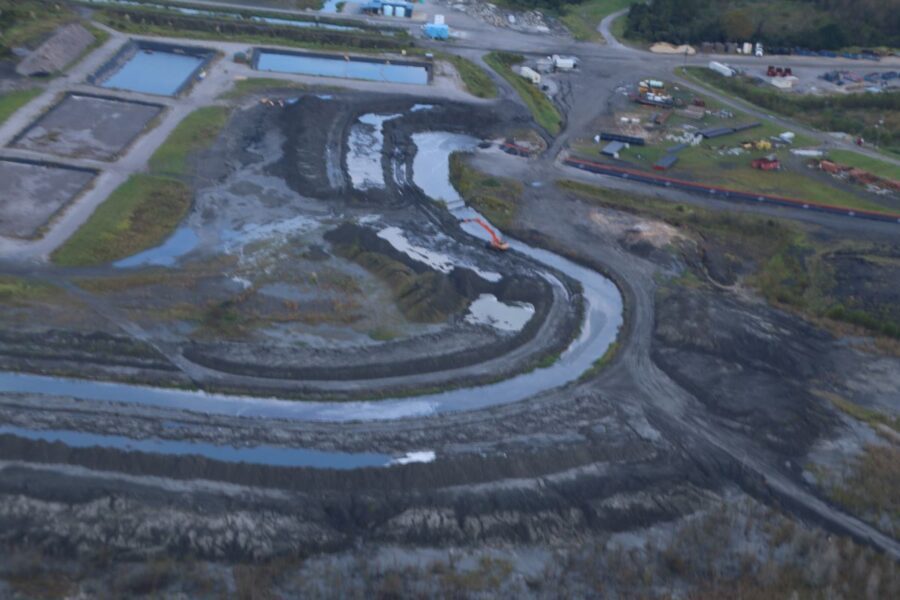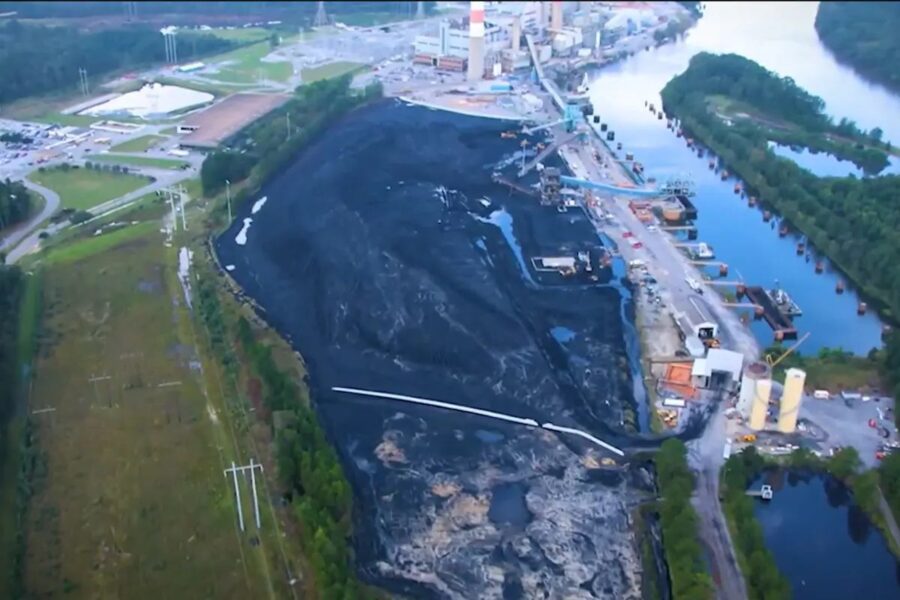Radioactive Risks Dangers of Toxic Coal Ash: In recent years, concerns about the radioactive risks and dangers associated with toxic coal ash have escalated, raising serious questions about the potential health and environmental impacts.
The Environmental Protection Agency’s (EPA) draft risk assessment on coal ash has shed light on the alarming levels of contamination present in unregulated settings, posing a significant threat to communities across the country.
However, one particular state, Alabama, faces unique challenges due to the lack of regulations in place to mitigate these risks effectively.
As the debate surrounding the issue intensifies, criticisms and calls for action have emerged, demanding immediate attention to safeguard public health and the environment.
But amidst these demands, skepticism from residents and other stakeholders adds another layer of complexity to the discussion, leaving us to wonder: what is the true extent of the radioactive risks and dangers associated with toxic coal ash, and how can we effectively address this pressing issue?
Key Takeaways
- The EPA’s draft risk assessment on coal ash reveals alarming findings about the potential health risks associated with exposure to coal ash.
- Coal ash contains hazardous substances, including heavy metals and radioactive elements, which can lead to respiratory problems, cardiovascular diseases, and cancer.
- Unregulated disposal of coal ash in unlined pits in Alabama poses significant risks to human health and the environment, including groundwater contamination and increased cancer risk.
- There is a lack of specific regulations and oversight for managing coal ash in Alabama, which exposes residents to radioactive and toxic risks.
EPA’s Alarming Draft Risk Assessment on Coal Ash
The Environmental Protection Agency’s (EPA) draft risk assessment on coal ash, released in November 2023, reveals alarming findings regarding the potential health risks associated with this toxic substance.
The assessment highlights the dangers posed by coal ash, even in small quantities.
Coal ash is created as a byproduct of burning coal for electricity, and it contains a wide range of hazardous substances, including heavy metals and radioactive elements.
The EPA’s analysis indicates that exposure to coal ash can lead to various health issues, such as respiratory problems, cardiovascular diseases, and even cancer.
Furthermore, the assessment suggests that these risks are not limited to those living in close proximity to coal ash disposal sites, as the toxic substances can travel through air and water, potentially impacting a larger population.
The EPA’s draft risk assessment underscores the urgent need for stringent regulations and measures to mitigate the risks associated with coal ash.

READ MORE: Alabama Power Unveils Plan to Recycle Mobile Coal Ash
Health Risks of Coal Ash in Unregulated Settings
Moving from the alarming findings of the EPA’s draft risk assessment on coal ash, attention now turns to the significant health risks posed by this toxic substance in unregulated settings. Unregulated disposal of coal ash can lead to the release of hazardous substances into the environment, which can have detrimental effects on human health.
Here are four key health risks associated with coal ash in unregulated settings:
- Exposure to heavy metals: Coal ash contains toxic heavy metals like arsenic, lead, mercury, and chromium, which can enter the body through inhalation, ingestion, or skin contact. These metals have been linked to various health issues, including respiratory problems, kidney damage, neurological disorders, and an increased risk of cancer.
- Radioactive contamination: Coal ash also contains radioactive isotopes like uranium and thorium, which can emit harmful radiation. Prolonged exposure to these radioactive substances can increase the risk of cancer, particularly lung and bone cancers.
- Airborne particulate matter: The fine particles released from coal ash can be easily inhaled, leading to respiratory problems such as asthma, bronchitis, and even cardiovascular issues.
- Water contamination: When coal ash is disposed of in unregulated settings, it can leach into groundwater and nearby water bodies, contaminating drinking water sources. This can result in serious health risks, including organ damage, developmental issues, and an increased risk of cancer.
It is crucial to regulate the disposal of coal ash to minimize these health risks and safeguard public health.
Alabama’s Unique Challenges and Lack of Regulations
Alabama faces unique challenges and lacks regulations when it comes to the storage and disposal of coal ash. In the state, coal ash is commonly stored in unlined pits, which can pose significant risks to both human health and the environment. Additionally, Alabama lacks specific regulations addressing the management of coal combustion residuals (CCR) material, leaving citizens vulnerable to the potential dangers of unregulated ‘beneficial uses’ of coal ash, particularly in structural fill.
To illustrate the gravity of the situation, let’s take a look at the following table:
| Challenges Faced by Alabama | Lack of Regulations |
|---|---|
| Unlined pits for coal ash storage | Absence of specific regulations for CCR material |
| Increased risk of groundwater contamination | Lack of guidelines for disposal and transportation |
| Potential health hazards for nearby communities | No requirement for monitoring and reporting |
This lack of oversight and regulation in Alabama leaves the state’s residents exposed to the potential radioactive and toxic risks associated with coal ash. It is imperative that effective regulations be put in place to ensure the safe storage and disposal of coal ash and protect the well-being of the population and the environment.
Criticisms and Calls for Action
Amidst the unique challenges faced by Alabama and the absence of regulations, concerns have been raised by environmental groups, academics, and media outlets, calling for action and criticizing the promotion of beneficial uses of coal ash as a means to bypass environmental regulations.
The following are the key criticisms and calls for action:
- Health risks: Environmental groups and academics express concerns about potential health risks for communities living near coal ash disposal sites or using products made from coal ash.
- Slow EPA action: Critics argue that the Environmental Protection Agency (EPA) has been slow to address the issue, especially in states like Alabama where repeated fines for groundwater contamination have been issued.
- Lack of regulations: The absence of strict regulations allows utilities to promote the beneficial uses of coal ash, which critics argue is a way to avoid complying with environmental standards.
- Media scrutiny: Media outlets have played a crucial role in highlighting the risks associated with coal ash and urging authorities to take immediate action to protect public health and the environment.

Demands for Action and Skepticism from Residents
Demands for concrete actions and skepticism from residents underscore the need to address the risks associated with unregulated uses of coal ash. Environmental advocates and community groups have called for specific actions to mitigate these risks. They urge a comprehensive evaluation of health risks, including the investigation and cleanup of affected areas.
Rulemaking to prohibit the use of coal ash as structural fill is also demanded, along with a public advisory for an immediate halt to coal ash fill in residential areas. These demands reflect the urgency felt by residents who have experienced the harmful effects of unregulated coal ash use.
Esther Calhoun, a resident of Uniontown, Alabama, exemplifies the skepticism among affected communities, highlighting the pressing need for concrete actions to address the dangers posed by toxic coal ash.
Conclusion Of Radioactive Risks Dangers of Toxic Coal Ash
The alarming draft risk assessment by the EPA highlights the potential health risks associated with coal ash in unregulated settings.
The lack of regulations in Alabama further exacerbates the challenges in managing these dangers.
Criticisms and calls for action have emerged, emphasizing the need for immediate measures to address the radioactive risks of toxic coal ash.
The demands from skeptical residents underscore the urgency to prioritize public health and safety in dealing with this pressing issue.
Our Reader’s Queries
Is coal ash reusable?
Coal ash can undergo beneficial reuse by being recycled for tasks like concrete production or road construction. The Coal Combustion Residuals (CCR) Rule, initiated by the EPA in 2015, mandates companies to conduct groundwater testing, address contamination, and develop closure plans for coal ash units.
How do you recycle coal ash?
Coal ash finds various reuses, such as being employed as structural fill or for filling abandoned mines. It serves as a top layer on unpaved roads, an ingredient in concrete, wallboard, and school running tracks. Additionally, it functions as an agricultural soil additive and is used as “cinders” for spreading on snowy roads.
What is radioactive in coal ash?
Radioactive elements in question encompass uranium (U), thorium (Th), along with their various decay products like radium (Ra) and radon (Rn). While these elements pose lower chemical toxicity compared to coal constituents like arsenic, selenium, or mercury, concerns have been raised regarding potential risks associated with radiation.

